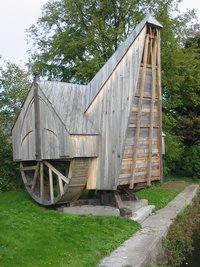Crane (machine)
|
|
TowerCrane.jpg
A crane is a tower or derrick equipped with cables and pulleys that is used to lift and lower materials. Cranes are commonly used in the construction industry and in manufacturing heavy equipment. Construction cranes are usually temporary structures, either fixed to the ground or mounted on a purpose-built vehicle. Cranes may either be controlled from an operator in a cab that travels with the crane, by a pushbutton pendant control station, or by infrared or radio remote control. Where a cab operator is employed, workers on the ground will communicate with the operator through a system of hand-signals; an experienced crew can position loads with great precision using only these signals.
| Contents |
Types of cranes
Ancient cranes
Although lacking direct evidence, some have purported that modern calculations reveal the Great Pyramid of Giza impossible to construct in a reasonable time frame (see Great Pyramid of Giza: Labor and Moscow Papyrus) without the aid of a sort of ancient Egyptian crane.
A carved stone relief [1] (http://www.bib-arch.org/bswb_AO/bswbao0804ancient.html) from the first or second century found in the tomb of the Haterii family in Rome shows a crane being used to build a monument.
Medieval cranes
Cranes in the Middle Ages were used to build Europe's cathedrals. The crane would be fixed on top of a wall as it was being constructed and was powered by men running inside two large wheels on each side.
Mobile crane
The most basic type of crane consists of a steel latticework boom mounted on a mobile platform. The boom is hinged at the bottom, and can be raised and lowered by cables. A hook is suspended from the top of the boom by cables and pulleys. The cables are operated by electric motors (although in old cranes they were operated by clutches driven by the crane's internal combustion engine). This type of crane is easily converted to a demolition crane by adding a demolition ball, or to an earthmover by adding a bucket.
Telescopic crane
This is a type of mobile crane whose boom consists of a number of square tubes fitted one inside the other. When the crane is deployed on site, a hydraulic mechanism extends the tubes to increase the working height.
Tower.crane.bristol.arp.jpg
Tower crane
Fixed to the ground, tower cranes often give the best combination of height and lifting capacity and are used in the construction of tall buildings. To save space, the vertical part of the crane is often built in a well in the centre of the building, which is then converted to a lift (elevator) shaft when the crane is dismantled. A horizontal boom is balanced asymmetrically across the top of the tower. Its short arm carries a counterweight of concrete blocks, and its long arm carries the lifting gear. The crane operator sits in a cabin at the top of the tower.
A tower crane is usually assembled by a telescopic crane of smaller lifting capacity but greater height, and in the case of tower cranes that have risen while constructing very tall skyscrapers a smaller crane will sometimes be lifted to the roof of the completed tower to dismantle the tower crane afterward. A self-assembling tower crane has been demonstrated, which lifts itself off the ground using jacks, allowing the next section of the tower to be inserted at ground level.
Loader crane
This is an hydraulically-powered articulated arm fitted to a trailer, used to load goods onto the trailer. The numerous jointed sections can be folded into a small space when the crane is not in use. One of the sections may be telescopic. A well-known manufacturer of loader cranes is the Swedish company Hiab (Hydrauliska Industri AB).
Gantry crane
800px-Hamburg.CTA.Altenwerder.BungaRaya.wmt.jpg
20050319_029_bristol_cranes.jpg
Overhead crane
This type of crane is usually seen in a manufacturing facility, and some of them can lift very heavy loads. The hoist is mounted on a trolley which moves in one direction along one or two beams. The beams can move in the orthogonal direction along elevated tracks, often mounted along the side of an assembly area.
Stacker crane
A crane with a forklift type mechanism used in automated (computer controlled) warehouses (known as an automated storage and retrieval system (AS/RS)). The crane moves on a track in an aisle of the warehouse. The fork can be raised or lowered to any of the levels of a storage rack and can be extended into the rack to store and retrieve product. The product can in some cases be as large as an automobile. Stacker cranes are often used in the large freezer warehouses of frozen food manufacturers. This automation avoids requiring forklift drivers to work in below freezing temperatures every day.
Floating crane
Floating cranes are used mainly in bridge building and port construction, but they are also used for occasional loading and unloading of especially heavy or awkward loads on and off ships. Some specialized crane barges have a lifting capacity exceeding 10,000 tons and have been used to transport entire bridge sections. Floating cranes have also been used to salvage sunken ships.de:Kran he:עגורן nl:Hijskraan ja:クレーン pl:Żuraw (urządzenie dźwigowe)

